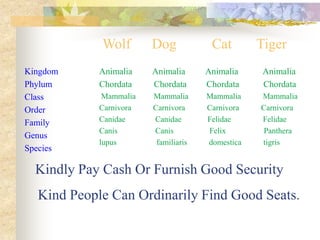
Invertebrates2006
- 1. Wolf Dog Cat Tiger Kingdom Animalia Animalia Animalia Animalia Phylum Chordata Chordata Chordata Chordata Class Mammalia Mammalia Mammalia Mammalia Order Carnivora Carnivora Carnivora Carnivora Family Canidae Canidae Felidae Felidae Canis Canis Felix Panthera Genus lupus familiaris domestica tigris Species Kindly Pay Cash Or Furnish Good Security Kind People Can Ordinarily Find Good Seats.
- 2. The science of grouping and naming organisms Taxonomy: on the basis of their similarities Ancient System of Classification (Aristotle (384-322) 1. Animals: 2. Plants: air dwelling, herb, shrub, or tree land dwelling or water dwelling
- 3. Modern System of Classification (Carolus Linnaeus) Kingdom Animalia Animalia Phylum Chordata Chordata Class Mammalia Mammalia Order Primates Primates Family Hominidae Pongidae Genus Homo Pan Species sapien troglodyte variety, breed or race
- 4. C. Binomial Nomenclature: system of naming organisms using “2” names 1. The scientific name of an organism consists of its GENUS name (capitalized) followed by its species name (both underlined or italicized) 2. Examples: Human Homo sapien or Homo sapien ??? Canis familaris ??? Canis lupus ??? Felix domestica
- 5. D. Five Kingdom Classification Monera (Bacteria) Protista (Protozoa, Algae) Fungi (Mushrooms, mold, mildew…) Plants (Flowering, Non-Flowering) Animals (Invertebrates,Vertebrates)
- 6. INVERTEBRATES: ANIMALS WITHOUT BACKBONES Major Phyla: Porifera Coelenterata Mollusca Echinodermata Platyhelminthes Nematoda Annelida Arthropoda
- 7. Porifera Once thought of as being plants because they are sessile, these porous animals filter the water for food particles. Sponge can be found both in freshwater and in saltwater.
- 8. Coelenterata Most of the animals in this phylum have hollow, sac-like bodies and stinging tentacles. Members include coral, sea anemones, jellyfish and hydra.
- 9. MOLLUSCA These are the soft-bodied animals. Besides being known for their fleshy bodies, mollusks usually have protective outer shells. Examples include the bivalves such as clams and the univalves such as snails.
- 10. ECHINODERMATA These are known as the Spiny-Skinned Animals This phylum includes starfish, brittle star, sand dollar and sea urchin. All echinoderms are marine animals.
- 11. Platyhelminthes Better known as Flat Worms Some may be free- living while others are harmful parasites Examples include tapeworms, flukes and the harmless planaria
- 12. Nematoda Better known as round worms, many nematodes are important as decomposers while others are dangerous parasites in humans and our pets. Nematodes include heartworms, hookworms, trichina worms, guinea worms...
- 13. ANNELIDA These are the segmented worms. Examples include earthworms, marine sand worms, and leeches.
- 14. Arthropoda The largest group of animals in the world “Arthropoda” means jointed-legged The 5 main clases of arthropods include insects, arachnids, crustaceans, millipedes and centipedes.